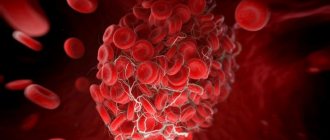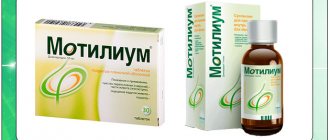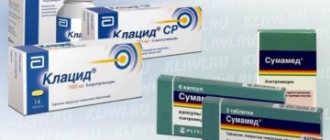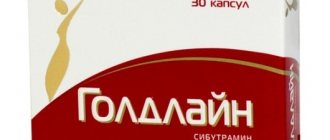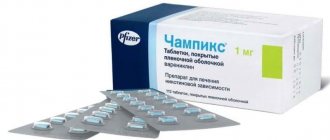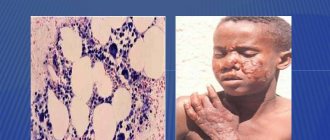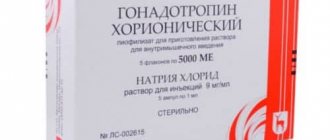Release form and composition
The drug is produced in the form of tablets: flat, round, from white to almost white, with a score on one side and a bevel on both sides (10 pieces in a blister of two-layer PVC/PVDC film and aluminum foil or three-layer PVC/PVDC/PVC film ; in a cardboard box 1 or 2 blisters).
Composition of 1 tablet:
- Active ingredients: thiamine hydrochloride – 38.75 mg, caffeine 50 mg, metamizole sodium 500 mg;
- Additional components: magnesium stearate, talc, colloidal silicon dioxide, gelatin, wheat starch, microcrystalline cellulose.
Composition of the drug
Sedalgin is available in the form of flat, round, white tablets for oral administration. They are packaged in blisters of 10 pieces. One cardboard package contains 1 or 2 blisters plus instructions for use. Excipients: wheat starch, colloidal silicon dioxide, gelatin, talc, magnesium stearate, microcrystalline cellulose. The main composition of the drug Sedalgin is multicomponent, this includes:
- thiamine hydrochloride – 39 mg/tab.;
- metamizole sodium – 500 mg/tab.
- caffeine – 50 mg/tab.
Metamizole sodium
A representative of the group of non-steroidal anti-inflammatory drugs, it belongs to pyrazolone derivatives. In Russia, metamizole sodium is better known as analgin. The substance has analgesic and weak antipyretic properties. The principle of its operation is based on suppressing the synthesis of prostaglandins, which are the main mediators of pain at the site of inflammation.
After oral administration, metamizole is quickly and completely absorbed from the gastrointestinal tract. The maximum concentration in blood plasma is reached after 60-90 minutes. Analgin binds to plasma proteins and is metabolized in the liver due to the active work of its enzymes. 90% of metabolites are excreted by the kidneys, 10% are excreted in bile. The half-life is approximately 10 hours.
Caffeine
The substance has a stimulating effect on the cerebral cortex. The active component enhances the functioning of the respiratory, vasomotor and nervous centers. Caffeine reduces drowsiness, relieves fatigue, increases performance, and helps reduce the severity of headaches. The substance is absorbed into the blood from the digestive tract and is completely distributed throughout the body in 30-40 minutes. Caffeine metabolites are excreted by the kidneys.
Thiamine
Better known as vitamin B1. It is responsible for the utilization of glucose, has a beneficial effect on nerve-reflex conductivity, and helps improve the functioning of the thyroid gland. After taking the tablet, absorption of thiamine occurs in the small intestine. Before absorption, the vitamin partially breaks down into phosphorus esters. Thiamine has the ability to accumulate in the heart, liver, spleen, kidneys, and brain. Excess substance is excreted in feces and urine.
Indications for use
Sedalgin Plus is recommended for use in mild to moderate pain syndromes of various origins:
- Myalgia (muscle pain);
- Neuralgia;
- Arthralgia (joint pain);
- Radicular syndrome;
- Toothache;
- Headache (including migraine);
- Algodismenorrhea (menstrual pain).
The drug is also used for febrile syndrome accompanying colds and other infectious and inflammatory lesions (with a diagnosed disease).
Statistics and facts
Sedalgin Plus (trade name) is a drug that has an analgesic, antipyretic and anti-inflammatory effect, used in the symptomatic treatment of many diseases of both the musculoskeletal system and other organs and systems.
Produced by the American Pharmaceutical Company, which also has a representative office in Russia. The manufacturer supplies the market with drugs that regulate the metabolism of the osteochondral system, as well as drugs for the treatment of oncological, neurological, therapeutic, ophthalmological and dermatological diseases.
One of the indications for the use of Sedalgin Plus is pain in diseases of the osteoarticular system, including arthrosis.
Arthrosis is a chronic disease of the osteoarticular system, accompanied by degenerative-dystrophic changes in the joints, their inflammation, deformation and dysfunction. The disease is quite common among the world's population - about seven percent of people suffer from it. There is an increase in incidence with age, which is associated with age-related changes in the osteoarticular system.
The etiology of damage to the capsule, synovium and joint ligaments has been sufficiently studied. The main reason is a violation of the normal metabolism of microelements and metabolic processes. Contributing factors include injuries, improper physical activity, obesity and other negative influences.
The first symptoms of arthrosis are usually pain and morning stiffness in the joint. A warm-up, massage, and gradual development of the limb after getting out of bed are required. There are three stages of development of degenerative-dystrophic joint damage. In the first, there are no pronounced changes in the structure and shape of the joint, the composition of the fluid inside the joint capsule is changed.
There is slight inflammation, the pain is not intense. At the second stage, the cartilage progressively degenerates, pain becomes constant and intolerable, and bone growths appear. The third stage is characterized by large areas of destruction of the joint, its deformation, pathological mobility and persistent limitation of movements develop.
Pain due to arthrosis intensifies at night, when the weather changes, and after physical activity. The correct diagnosis can be made by assessing the clinical picture and conducting laboratory and instrumental studies, including x-rays of the affected joint. After confirming the diagnosis and establishing the stage of the disease, it is necessary to immediately begin combined treatment, including both drug and non-drug therapy.
Contraindications
- Insomnia;
- Diseases of the blood system;
- Severe liver and/or kidney failure;
- Bronchospasm;
- Severe atherosclerosis;
- Uncontrolled arterial hypertension;
- Increased intraocular pressure;
- Glucose-6-phosphate dehydrogenase deficiency (congenital glucose-6-phosphate dehydrogenase enzyme deficiency syndrome);
- Age up to 12 years;
- Breastfeeding period and pregnancy;
- Hypersensitivity to the components of the drug, as well as to other pyrazolone derivatives (including phenylbutazone).
The drug should be used with extreme caution and under medical supervision (due to the risk of possible complications) for functional disorders of the liver and/or kidneys.
Side effects and contraindications
Sedalgin, as a rule, is well tolerated by patients, only sometimes unwanted side effects may occur. Negative reactions are manifested by the following organs and systems:
- digestive tract – loss of appetite, nausea, development of jaundice, vomiting;
- heart and blood vessels – arterial hypertension, rapid heartbeat;
- central nervous system – dizziness, insomnia, nervous excitability;
- hematopoiesis – hemolytic anemia, thrombocytopenia, leukopenia, agranulocytosis;
- allergic reactions - urticaria, itching, skin rash, swelling, anaphylactic shock, bronchospasm.
The drug can affect the speed of psychomotor reactions, so during treatment it is better to refrain from driving vehicles and working with complex mechanisms. Patients with atopic bronchial asthma have an increased risk of developing allergic reactions. Other contraindications include a number of such pathological and physiological conditions:
- hypersensitivity to one of the components of the drug;
- congenital deficiency of glucose-6-phosphate dehydrogenase;
- increased intraocular pressure;
- severe atherosclerosis;
- hypertension;
- arrhythmia;
- peptic ulcers of the digestive tract;
- anemia;
- myocardial infarction.
Use for children under 12 years of age
Prescribing Sedalgin Plus to a young child is potentially dangerous. Due to insufficient development of the child's body, drugs containing analgin or its derivatives can cause serious complications during treatment, one of which is considered Reye's syndrome. This condition is characterized by drug poisoning with damage to the cerebral cortex and the development of hepatic-renal failure.
Sedalgin Plus during pregnancy
The drug is contraindicated during pregnancy due to the negative impact on the functions of the hematopoietic system and increased stress on the kidneys. The caffeine contained in this drug passes into breast milk. For this reason, it is not recommended to use the medicine while breastfeeding. In the absence of analogues, lactation must be interrupted during treatment. You can resume feeding after 2-3 days.
For liver and kidney dysfunction
Due to the fact that the main conversion of the active components of the drug into metabolites occurs with the help of liver enzymes, and excretion is carried out by the kidneys, Sedalgin can be used by patients with moderate severity of liver or kidney failure only under strict medical supervision. Such treatment of pain syndrome is strictly prohibited for similar diseases with a severe course.
Directions for use and dosage
Sedalgin Plus is taken orally after meals in the first half of the day.
The recommended dosage regimen is 1 tablet 2-3 times a day.
For adolescents over 16 years of age and adults, the maximum single dose is 2 tablets, the maximum daily dose is 6 tablets, taken for no more than 1-2 days.
Children 12-16 years old are prescribed 2-3 times a day, ½ or 1 tablet, but not more than 4 tablets.
The course when using the drug as an analgesic is no more than 5 days, when used as an antipyretic – no more than 3 days. If signs of the disease do not disappear or worsen, you should consult your doctor.
Increasing the duration of therapy or daily dose is possible only as prescribed and under the supervision of a physician.
Analogs
All types of similar medicines and dietary supplements are represented by medicines with a similar content of active ingredients, spectrum of use, purpose or pharmacological action: Benalgin, Analgin-Dibazol-Papaverine, Andipal-B, Andipal-Neo, Andipal-Forte, Andipal-Extra, Analgin Quinine, Analdim, Kofalgin, Revalgin, Pentalgin, Pentalgin-P, Benamil-M, Naklofen duo, Diclofenac-teva, Diclofenac, Ortofen ointment 2%, Diclofenac-akrikhin, Ortofen, Diclofen, Diclonate p, Diclovit, Diclak, Diclogen , Naklofen sr, Dicloran plus and others.
Side effects
- Nervous system: increased excitability, dizziness, insomnia;
- Digestive system: nausea, loss of appetite, vomiting, jaundice, cholestasis;
- Cardiovascular system: arrhythmia, palpitations;
- Hematopoietic system: purpura, hemolytic anemia, agranulocytosis, leukopenia, thrombocytopenia;
- Allergic reactions: anaphylactic shock, skin rash, redness, itching, Quincke's edema, bronchospasm.
Any type of side effects that occur during therapy must be reported to your doctor.
Symptoms of overdose are: dehydration, delirium, confusion, anxiety, convulsions, increased or decreased urine output, heart rhythm disturbances, tachycardia, motor and mental agitation, stomach pain, nausea and vomiting (sometimes with blood), muscle twitching or tremors, increased pain or tactile sensitivity, ringing in the ears, headache, hyperthermia, epileptic seizures (in case of acute overdose - tonic-clonic seizures).
In this condition, gastric lavage, adsorbents (activated carbon) and laxatives, and symptomatic therapy are prescribed.
In case of hemorrhagic gastritis, the stomach is washed with ice-cold isotonic sodium chloride solution (0.9%) and antacids are administered; for epileptic seizures, measures are taken to maintain the balance of salts and fluids, and intravenous injections of diazepam, phenytoin or phenobarbital are given.
Overdose
The analgesic drug is sold from pharmacies without a prescription, which is often abused by patients without following the recommendations from the instructions. Exceeding the dosage given by the manufacturer can lead to serious side effects and even calling an ambulance. If you accidentally take an extra pill and notice unpleasant symptoms, consult your doctor immediately.
Is it possible to increase the daily dose on your own?
When joint pain, migraine, or toothache occurs, health workers prescribe painkillers in a dosage that corresponds to the patient’s age, diagnosis and recommended by the manufacturer of the tablets. Doubling or tripling the dose of the drug will not give a quick effect, but will only contribute to the appearance of harmful side effects. If the standard daily dosage does not give the expected effect, do not take additional tablets; it is better to ask your doctor to replace Sedalgin Plus with an analogue.
Taking Sedalgin Plus while consuming caffeine-containing products
Do not take tablets with alcohol-containing drinks, caffeine or strong tea. It is not recommended to consume these drinks after taking the pill. The justification for the recommendations is simple. Coffee, strong tea and some other products contain caffeine, which is already included in Sedalgina Plus in normal daily dosages. This combination of products and tablets can lead to overdose symptoms and worsen the patient's condition.
Symptoms of drug poisoning
Negative reactions may occur in the cardiovascular, nervous or respiratory systems. The main symptoms of overdose are:
- nausea, possibly vomiting blood;
- motor or nervous excitement;
- pain in the epigastric region;
- tachycardia;
- increase or decrease in urine volume;
- heart rhythm disturbance;
- confusion, speech;
- hyperthermia;
- migraine;
- dehydration of the body;
- limb spasms;
- increased tactile sensitivity of the skin;
- epileptic seizures;
- tinnitus;
- dizziness;
- nervous tic.
Treatment of overdose
If you accidentally took a double dose of tablets and feel unwell, you should immediately consult a doctor or call an ambulance. Providing first aid to the victim consists of the following activities:
- The patient undergoes gastric lavage, after which sorbents are prescribed: activated carbon, Enterosgel or others.
- If symptoms of hemorrhagic gastritis occur, gastric lavage is done with sodium chloride solution and antacids are administered.
- If there is difficulty breathing, the victim is prescribed oxygenation or provided with artificial ventilation of the lungs using a machine.
- For epileptic seizures, an injection of Diazepam is given intravenously, and Phenytoin or Phenobarbital is additionally prescribed.
- In all cases, after poisoning, the balance of fluid and salt in the body is constantly monitored until it is completely restored.
special instructions
While taking Sedalgin Plus, excessive consumption of products containing caffeine may provoke signs of overdose.
It is not recommended to combine the drug with ethanol.
In the presence of hay fever and atopic bronchial asthma, the threat of developing hypersensitivity reactions is aggravated.
Increased caution is required when driving vehicles or other complex machinery due to the possibility of dizziness during therapy.
Drug interactions
- Allopurinol, oral contraceptives, tricyclic antidepressants - the metabolism of metamizole sodium (analgin) in the liver is disrupted and its toxicity increases;
- Tranquilizers, sedatives - the analgesic effect of Sedalgin Plus is enhanced;
- Non-steroidal anti-inflammatory drugs, other non-narcotic analgesics – mutual enhancement of toxic effects is possible;
- Phenylbutazone (butadione), barbiturates and other inducers of microsomal liver enzymes - the effect of metamizole sodium is weakened;
- Cyclosporine - the level of its content in the blood will decrease.
pharmachologic effect
The active substance of the drug is metamizole sodium. This substance belongs to the group of non-narcotic analgesics and has an analgesic and antipyretic effect on the body. This component does not depress the respiratory system and does not have a hypnotic or euphoric effect. Metamizole sodium has a membrane-stabilizing effect.
Caffeine has a slight effect on the activity of the central nervous system; the main effect of this component is to constrict blood vessels. This eliminates certain types of headaches and hypotension. In some painful conditions, caffeine can dull pain. Caffeine in combination with an analgesic provokes the development of a synergistic effect.
The caffeine contained in the drug is absorbed almost completely.
Its maximum concentration in the blood is reached 30-40 minutes after taking the tablet. This substance passes through the blood-brain and placental barriers quite quickly. Method of excretion through the kidneys.
Thiamine hydrochloride vitamin B1. He takes an active part in metabolic processes. Thiamine is a component of many enzymes and is highly absorbed throughout the entire length of the small intestine. The concentration of thiamine in the patient's blood is quite low. Free thiamine is present in plasma, and its phosphorus esters can be detected in leukocytes and erythrocytes. This substance can accumulate in the heart, brain and kidneys. Excreted through the kidneys or intestines.
Sedalgin is absorbed quite quickly: the therapeutic effect is observed within half an hour to an hour after taking the drug.

